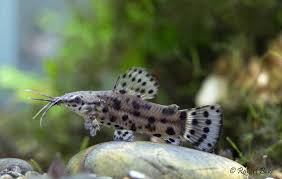
Hoplo Catfish (Tarakatum)
Conditions of detention
Hoplo Catfish are adaptable and thrive in a well-maintained tank with a minimum size of 30 gallons. They prefer water temperatures between 72-79°F (22-26°C) and a pH range of 6.0 to 8.0, making them suitable for a wide range of aquariums. These catfish are bottom dwellers and appreciate a tank setup with a soft, sandy substrate, plenty of hiding spots like caves and driftwood, and a moderate amount of plants. They are peaceful and do well in community tanks with other non-aggressive fish.
Useful Fact: Hoplo Catfish are known for their unique breeding behavior, where the male builds a bubble nest on the water’s surface to protect the eggs.
Nutrition and diet
Hoplo Catfish are omnivorous and enjoy a varied diet. In the wild, they feed on small invertebrates, plant matter, and detritus. In captivity, they should be fed high-quality sinking pellets or wafers, supplemented with live or frozen foods such as bloodworms, brine shrimp, and daphnia. They also enjoy vegetable matter like blanched spinach, zucchini, and peas.
Useful Fact: Hoplo Catfish are excellent scavengers, helping to keep the tank clean by eating leftover food and organic debris from the bottom.
Health
Hoplo Catfish are generally hardy and resistant to many common fish diseases. However, like all fish, they can be susceptible to illnesses such as ich, especially if water quality is not maintained. Regular water changes and monitoring of water parameters are essential to prevent disease. They are also sensitive to copper-based medications, so treatments should be used cautiously.
Useful Fact: The armored body of the Hoplo Catfish provides added protection against injury and some parasites, contributing to their hardiness.
Grooming and care
Hoplo Catfish do not require traditional grooming, but their environment needs regular maintenance. Since they are bottom dwellers, it’s essential to keep the substrate clean by performing regular water changes (about 20-30% weekly) and using a good filtration system. Providing hiding spots and a varied diet also contributes to their well-being.
Useful Fact: Hoplo Catfish have an accessory breathing organ that allows them to gulp air from the surface, which is particularly useful in low-oxygen environments.
Education and training
Hoplo Catfish are not typically trained, but they can learn to recognize their owners and will often come out during feeding times. They are generally more active during the evening and night but may become more visible during the day as they become accustomed to their environment.
Useful Fact: Although primarily nocturnal, Hoplo Catfish can become more active during the day in a well-established, stress-free tank.
Toys and entertainment
Hoplo Catfish enjoy exploring their environment, especially the bottom of the tank. Providing them with a well-decorated tank that includes caves, driftwood, and plants will keep them entertained and reduce stress. They are also known to dig in the substrate, so a soft, sandy bottom is ideal.
Useful Fact: Hoplo Catfish are curious and enjoy digging, so offering a sandy substrate and various hiding spots keeps them stimulated and engaged.
Safety
Hoplo Catfish are peaceful and do well in community tanks with other non-aggressive fish. However, they should not be housed with very small fish that they might accidentally ingest. They are generally easygoing and not prone to causing harm to other tank inhabitants. It’s important to ensure that any tank decorations or rocks are stable, as they can be disturbed by the catfish’s digging behavior.
Useful Fact: Hoplo Catfish are sturdy and peaceful, making them ideal companions for a wide variety of community fish, including livebearers, tetras, and other catfish species.
Accessories
Essential accessories for a Hoplo Catfish tank include a reliable filter to maintain water quality, a heater to keep the temperature stable, and a soft, sandy substrate to protect their barbels. The tank should also include plenty of caves, driftwood, and plants to provide hiding spots. Moderate lighting and gentle water flow are ideal for mimicking their natural environment.
Useful Fact: Hoplo Catfish thrive in tanks with plenty of hiding spots and a soft substrate that allows them to engage in natural digging behaviors.
Socialization
Hoplo Catfish are social fish that do well in groups. They are peaceful and get along well with other community fish of similar size and temperament. Keeping them in small groups of three or more helps reduce stress and encourages natural social behavior. They are most active during the evening and night but can adapt to become more visible during the day in a well-maintained environment.
Useful Fact: Hoplo Catfish are most comfortable in groups, where they can display natural behaviors and form social bonds with their tankmates.
Travel and Transportation
When transporting Hoplo Catfish, use a plastic bag filled with water from their tank and ensure it is well-oxygenated. Transport them carefully to avoid temperature fluctuations and stress. Keep the bag in a dark, insulated container to minimize stress.
Useful Fact: Hoplo Catfish are relatively hardy during transport but should be acclimated slowly to their new environment to reduce stress and prevent shock.
Behavior and psychology
Hoplo Catfish are known for their peaceful, social nature and their interesting breeding behavior. They are generally bottom-dwellers and spend much of their time foraging in the substrate for food. Hoplo Catfish are also known for their ability to gulp air from the surface, which allows them to survive in low-oxygen environments. Their behavior is most natural and engaging when they feel secure in a well-maintained, community-oriented environment.
Useful Fact: Male Hoplo Catfish build bubble nests on the water’s surface to protect eggs, displaying a unique and fascinating breeding behavior.
Legal aspects
There are generally no legal restrictions on owning Hoplo Catfish, but it’s important to ensure they are sourced from reputable breeders or suppliers. As with all fish, ethical sourcing helps support sustainable practices and ensures the health of the fish.
Useful Fact: Hoplo Catfish are widely available in the aquarium trade and are often bred in captivity, making them a sustainable choice for aquarists.


